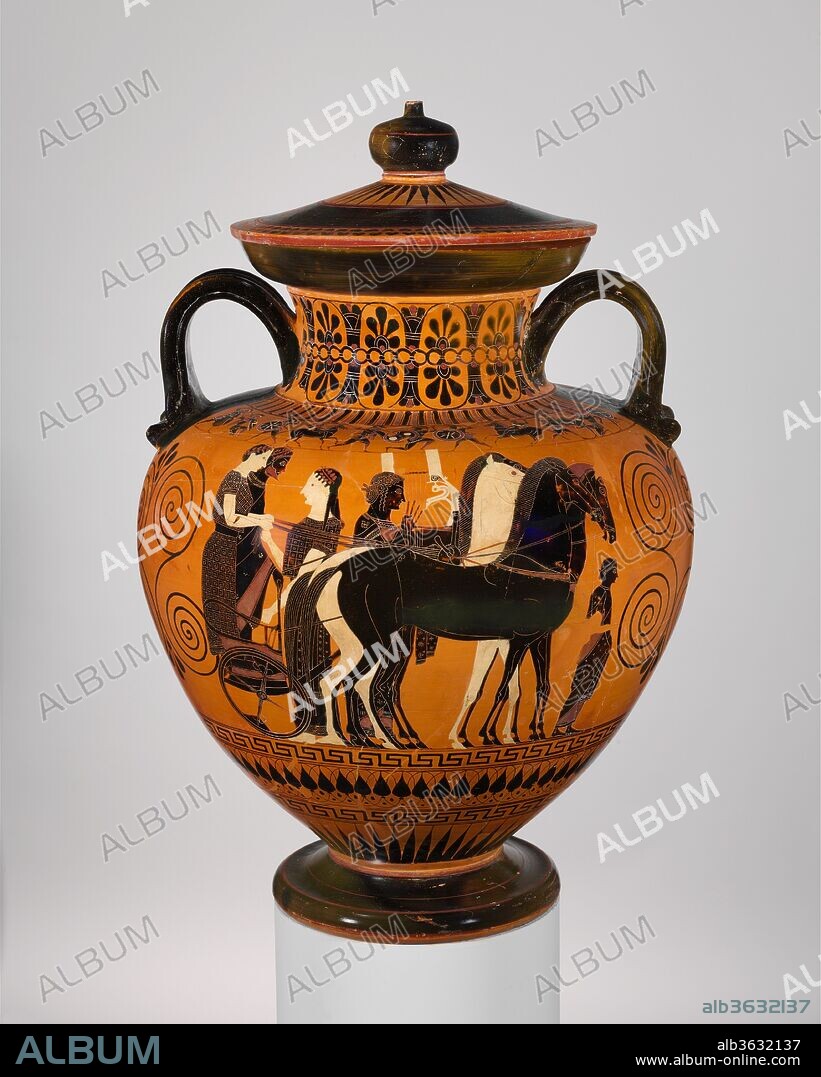alb3632137
Terracotta neck-amphora (jar) with lid and knob (27.16)

|
Añadir a otro lightbox |
|
Añadir a otro lightbox |



¿Ya tienes cuenta? Iniciar sesión
¿No tienes cuenta? Regístrate
Compra esta imagen.
Selecciona el uso:

Título:
Terracotta neck-amphora (jar) with lid and knob (27.16)
Descripción:
Traducción automática: Cuello-ánfora (tarro) de terracota con tapa y pomo (27.16). Cultura: griego, ático. Dimensiones: H. 18 1/2 pulg. (47 cm) de diámetro 9 3/4 pulg. (24,8 cm). Fecha: ca. 540 a.C. En el cuerpo, anverso y reverso, hombre y mujer en carro acompañados por mujer y cítara. En el hombro, combate de infantería y jinetes. La figura negra era una técnica engorrosa, restringida y bastante artificial. Los jarrones de esta sala dan testimonio de la variedad de efectos y de la contundencia expresiva que, no obstante, está permitida. Probablemente el mayor artista individual de figuras negras fue Exequias, que era ceramista y pintor. Aunque los ingredientes esenciales de esta obra son tradicionales, su particular carácter se manifiesta en la forma robusta, la extraordinaria precisión y vitalidad de las figuras y ornamentos, y la perfecta relación de los elementos decorativos con el cuerpo que se encuentra debajo.
Terracotta neck-amphora (jar) with lid and knob (27.16). Culture: Greek, Attic. Dimensions: H. 18 1/2 in. (47 cm)
diameter 9 3/4 in. (24.8 cm). Date: ca. 540 B.C..
On the body, obverse and reverse, man and woman in chariot accompanied by woman and kithara player
On the shoulder, combat of foot soldiers and horsemen
Black-figure was a cumbersome, restricted, and quite artificial technique. The vases in this room testify to the variety of effect and the forcefulness of expression that is nonetheless permitted. Probably the greatest single black-figure artist was Exekias, who was both potter and painter. Although the essential ingredients of this work are traditional, its particular character is evident in the robust shape, the extraordinary precision and vitality in the figures and ornament, and the perfect relation of the decorative elements to the body beneath.
Técnica/material:
Terracotta; black-figure
Periodo:
ARCHAIC
Museo:
Metropolitan Museum of Art, New York, USA
Crédito:
Album / Metropolitan Museum of Art, NY
Autorizaciones:
Tamaño imagen:
3368 x 4200 px | 40.5 MB
Tamaño impresión:
28.5 x 35.6 cm | 11.2 x 14.0 in (300 dpi)
Palabras clave:
 Pinterest
Pinterest Twitter
Twitter Facebook
Facebook Copiar enlace
Copiar enlace Email
Email
